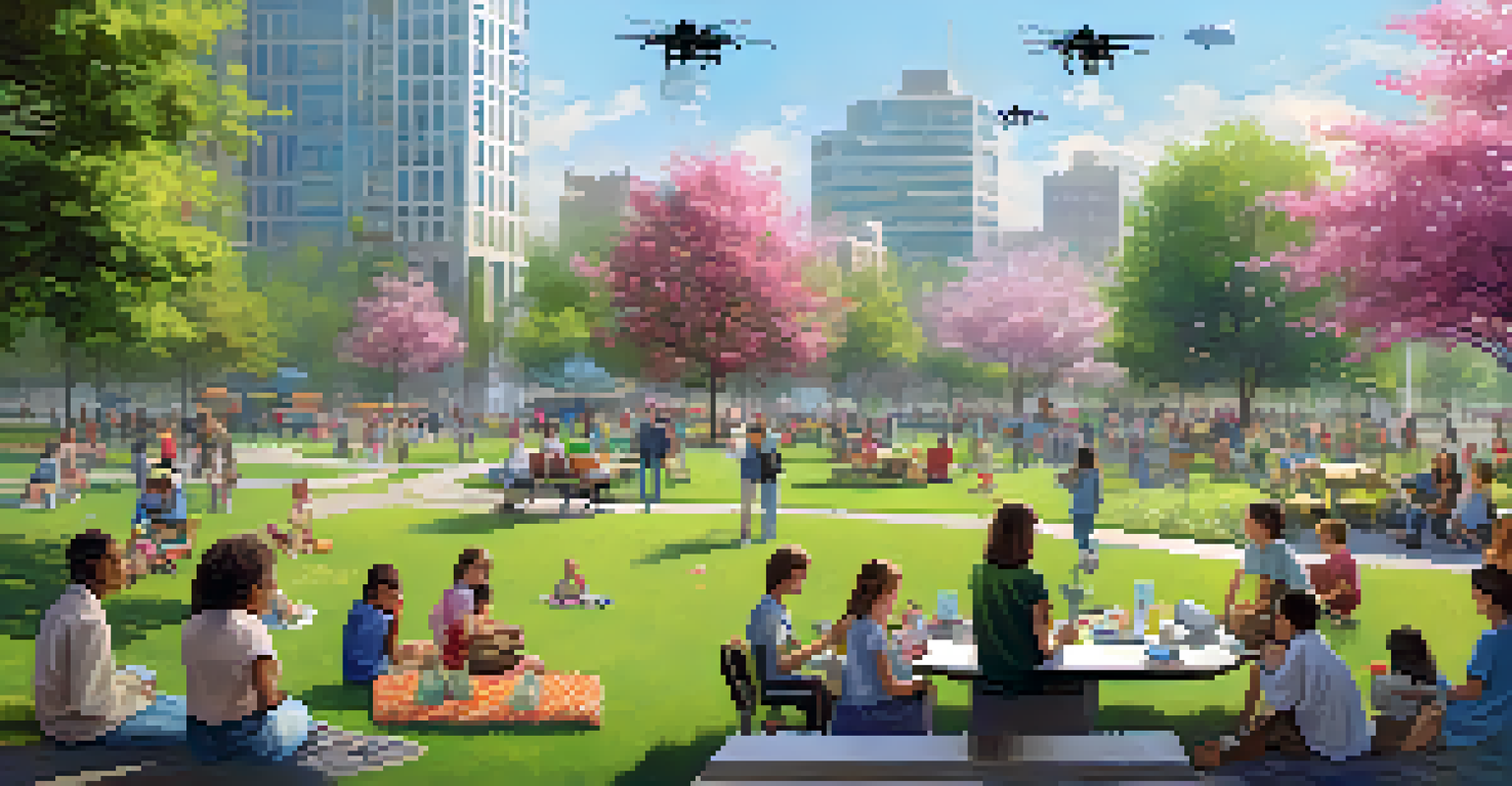Exploring the Role of Robotics in Smart Cities

What Are Smart Cities and Their Challenges?
Smart cities are urban areas that use digital technology to enhance performance, reduce costs, and engage more effectively with residents. They aim to improve quality of life through efficient resource management and sustainable practices. However, these cities often face challenges such as traffic congestion, energy consumption, and waste management.
The future is already here – it's just not evenly distributed.
To tackle these issues, smart cities need innovative solutions that can adapt to changing urban environments. The integration of robotics offers a promising approach, as these technologies can automate processes and provide valuable data insights. For example, robotic systems can monitor traffic patterns, allowing cities to optimize their transportation networks.
By leveraging robotics, smart cities can create more responsive and resilient infrastructures. This not only benefits residents by improving their daily lives but also attracts businesses and investments, making urban areas more competitive.
Robotics in Public Transportation Systems
Public transportation is a cornerstone of smart cities, and robotics plays a crucial role in its evolution. Autonomous vehicles, such as self-driving buses and shuttles, are being tested in various cities around the world. These vehicles promise to reduce traffic congestion and enhance accessibility for passengers.

Moreover, robotic systems can optimize transit schedules and routes based on real-time data. For instance, smart algorithms analyze commuter patterns and adjust service levels accordingly, ensuring that public transport meets the needs of its users. This dynamic approach not only improves efficiency but also increases rider satisfaction.
Smart Cities Leverage Robotics
Smart cities utilize robotics to enhance urban efficiency, improve resource management, and engage residents more effectively.
As cities continue to embrace robotics in transportation, we can expect safer, more efficient, and environmentally friendly transit options. This shift will likely encourage more residents to utilize public transport, reducing reliance on personal vehicles and contributing to cleaner urban air.
Enhancing Urban Safety with Robotics
Safety is a top priority for any urban environment, and robotics can significantly enhance this aspect. Surveillance drones and robotic patrol units are increasingly deployed to monitor public spaces and ensure safety. These technologies can quickly identify potential threats and respond faster than human officers.
The city is not a concrete jungle, it is a human zoo.
Additionally, robots equipped with sensors can detect hazardous conditions, such as gas leaks or fires, and alert emergency services. This capability not only protects residents but also allows for a more efficient allocation of resources during emergencies. For instance, a fire-fighting drone can assess a situation before human firefighters arrive, providing crucial information.
By incorporating robotics into urban safety strategies, cities can foster a sense of security among residents. This not only improves the overall quality of life but also encourages community engagement and participation in local safety initiatives.
Robotics in Waste Management Solutions
Waste management is a significant challenge in urban areas, and robots are stepping in to help streamline this process. Automated waste collection systems, such as robotic garbage trucks, can operate more efficiently than traditional methods. These robots can follow designated routes while optimizing their paths based on real-time data.
Moreover, robotic systems can also assist in sorting recyclable materials at waste processing facilities. Using advanced sensors and AI, these robots can identify and separate different types of waste, improving recycling rates. This not only reduces landfill waste but also promotes sustainable practices within communities.
Robotics Enhance Urban Safety
Robotic technologies, such as drones and surveillance units, are deployed in urban areas to improve safety and emergency response.
As cities continue to grow, integrating robotics into waste management will be essential for maintaining clean and livable urban environments. By focusing on efficiency and sustainability, cities can enhance their waste management systems and contribute to a healthier planet.
Smart Infrastructure Maintenance with Robotics
Maintaining infrastructure is vital for the longevity of smart cities, and robotics can play a key role in this area. Drones equipped with cameras and sensors can routinely inspect bridges, roads, and buildings, identifying potential issues before they escalate. This proactive approach ensures that maintenance is timely and cost-effective.
In addition, robotic systems can perform repairs in hard-to-reach areas, such as high-rise buildings or underwater structures. For instance, robotic arms can conduct maintenance work on wind turbines, reducing the need for human workers in hazardous environments. This not only enhances safety but also increases the efficiency of repair operations.
By adopting robotic technologies for infrastructure maintenance, smart cities can ensure their structures remain safe and functional. This commitment to upkeep not only protects residents but also fosters trust in local government and services.
The Role of Robotics in Urban Agriculture
Urban agriculture is gaining momentum in smart cities, and robotics is revolutionizing how food is grown in urban environments. Automated farming systems, such as vertical farms and robotic planters, allow for efficient food production within city limits. These technologies maximize space and minimize resource usage, addressing food security challenges.
Robotic systems can also monitor plant health, automate irrigation, and even harvest crops. For example, sensors can detect when plants need water or nutrients, ensuring optimal growth conditions. This precision agriculture approach not only increases yields but also reduces waste and environmental impact.
Challenges in Robotics Adoption
Despite the benefits, challenges like data privacy and public acceptance must be addressed for successful robotics integration in smart cities.
By integrating robotics into urban agriculture, cities can promote local food production and sustainability. This not only benefits residents with fresh produce but also encourages community involvement and awareness of food systems.
Challenges and Future of Robotics in Smart Cities
While the benefits of robotics in smart cities are clear, there are challenges to consider. Issues such as data privacy, job displacement, and the high costs of implementation require careful thought. As cities adopt new technologies, it’s vital to ensure that ethical considerations are at the forefront of decision-making.
Moreover, public acceptance of robotics is crucial for successful integration. Education and community engagement initiatives can help alleviate fears surrounding automation and showcase the positive impacts of robotics on daily life. For instance, workshops can demonstrate how autonomous vehicles enhance transportation options rather than replace jobs.

Looking ahead, the future of robotics in smart cities appears promising. As technology continues to evolve, we can expect even more innovative applications that improve urban living. By addressing challenges and fostering collaboration between stakeholders, cities can harness the full potential of robotics for sustainable development.